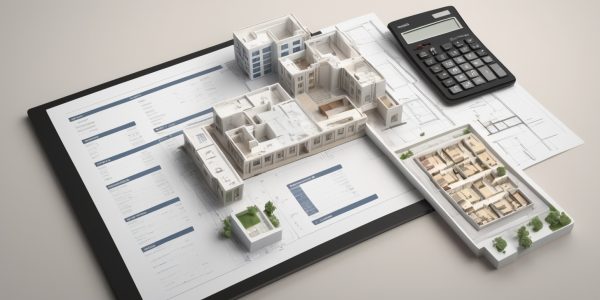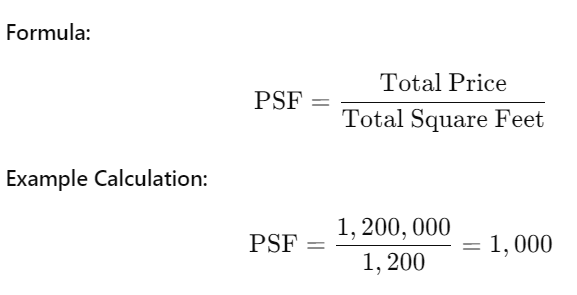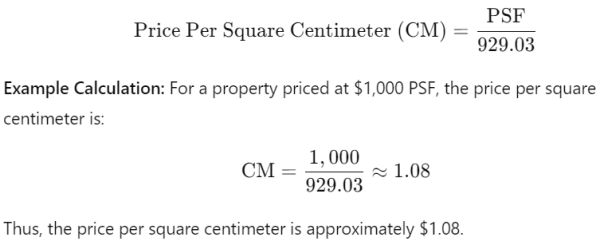Introduction
In real estate, the price per square foot (PSF) plays a key role in determining property value, comparing different properties, and making informed purchasing decisions. Whether you’re a seasoned investor or a first-time buyer, understanding PSF empowers you to assess the value of properties more effectively. In this guide, we’ll explore what PSF is, how to calculate it, and how to convert it into other units like square meters and square centimeters. Let’s dive in!

What is Price Per Square Foot (PSF)?
PSF, or price per square foot, is a standard measurement in real estate that indicates the cost of a property per square foot of area. This metric simplifies comparisons between properties, allowing buyers to see how much they’re paying for each unit of space, regardless of total property size.
For example, if two properties are similar in size but one has a higher PSF, it’s typically considered more valuable or located in a more desirable area. On the other hand, a lower PSF could indicate a property in need of upgrades or one situated in a less prime location.
How to Calculate PSF
Calculating PSF is straightforward and requires only two main pieces of information: the total price of the property and its size in square feet. Here’s a step-by-step guide:
- Determine the Property Price: First, find the listing or purchase price of the property. For instance, let’s say a condo is selling for $1,200,000.
- Measure the Property Size in Square Feet: Next, find the property’s total area in square feet. If the condo is 1,200 square feet, this will be the size value used in your calculation.
- Apply the PSF Formula: Simply divide the property price by the square footage to get the PSF value.

Factors that Influence PSF
PSF can vary widely based on several factors, making it essential to understand what affects this metric when evaluating a property. Key factors include:
- Location: Properties in prime areas typically have a higher PSF due to proximity to amenities, schools, and transport links.
- Building Age and Condition: Newer or well-maintained properties often command a higher PSF compared to older ones needing repairs.
- View and Orientation: Units with unobstructed views or favorable orientations (e.g., facing a park or water body) generally have a higher PSF.
- Floor Level: High-rise properties may see higher PSF values on upper floors, especially when the view is scenic.
Understanding these factors allows you to make informed comparisons and identify properties that align with your preferences and budget.
Converting PSF to Other Units: Square Meters and Square Centimeters
PSF is a commonly used metric, but some buyers and investors may need to work in different units, especially in international contexts. Here’s how you can convert PSF into square meters (SPM) and square centimeters (CM).
Conversion Formula:Price Per Square Meter (SPM)=PSF×10.764\text{Price Per Square Meter (SPM)} = \text{PSF} \times 10.764Price Per Square Meter (SPM)=PSF×10.764
Example Calculation: If a property has a PSF of $1,000, the conversion to price per square meter is:SPM=1,000×10.764=10,764\text{SPM} = 1,000 \times 10.764 = 10,764SPM=1,000×10.764=10,764
So, the price per square meter is $10,764.
PSF to CM (Square Centimeters)
For those needing finer unit details, converting PSF to square centimeters is also possible. Since there are 929.03 square centimeters in one square foot, use this factor to calculate price per square centimeter.
Conversion Formula:

Why PSF Matters in Property Investment
PSF offers a snapshot of property value, making it a useful metric for both investors and homebuyers. Investors, for instance, often use PSF to gauge rental yields and potential appreciation. A lower PSF in a rapidly developing area might signify a good investment opportunity, while a high PSF in a saturated market may suggest limited growth potential.
For homebuyers, PSF allows for clearer comparisons across properties. By examining the PSF along with factors like location, amenities, and nearby development plans, buyers can ensure they’re getting fair value for each square foot of property they’re purchasing.
How to Use PSF Data Wisely
To make the most of PSF data, consider the following tips:
- Compare with Similar Properties: Don’t just look at one property’s PSF. Compare it to similar properties in the area to understand local market trends.
- Examine Property Upgrades: Properties with recent upgrades may have a higher PSF, but this can add immediate value and comfort to the buyer.
- Factor in Long-Term Value: A lower PSF in an up-and-coming area could provide better value over time compared to a high PSF in a location with limited future growth.
Using these tips, you can maximize the value of PSF data in your property decisions.
Examples of How PSF Reflects Property Value in Different Areas
Let’s say you’re looking at two condos: one in a prime central district and another in a developing neighborhood. The central condo has a PSF of $2,500, while the other has a PSF of $1,200. The higher PSF in the central district reflects premium location benefits, proximity to key amenities, and demand. Meanwhile, the lower PSF in the developing area could offer value appreciation over time as the area matures and new amenities are introduced.
This comparison demonstrates how PSF varies across locations and highlights its usefulness in understanding the value relative to different factors.
Conclusion
Price per square foot (PSF) is a vital metric in real estate, helping buyers and investors make sense of property values across different regions and property types. By calculating PSF and understanding its influencing factors, you can make more informed choices in Singapore’s competitive property market. Plus, with the ability to convert PSF into square meters and square centimeters, you’re well-equipped to evaluate properties in a range of contexts.
Remember, PSF is just one part of the equation. Always consider other factors like location, building condition, and market trends to ensure you’re making the best possible investment or home purchase decision.

